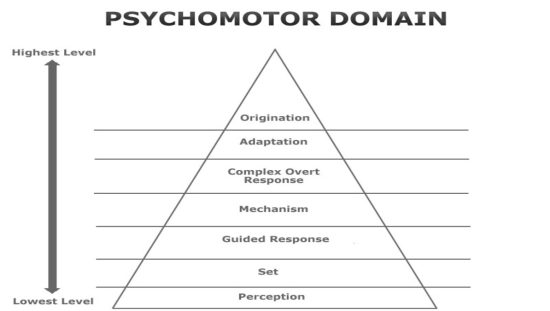Krathwohl’s affective domain taxonomy is perhaps the best known of any of the affective taxonomies. The affective domain focuses on the attitudes, values, interests, and appreciation of learners. This domain includes the manner in which individuals deal with things emotionally, such as feelings, values, appreciation, enthusiasms, motivations, and attitudes.
The affective domain was addressed in 1965 in Taxonomy of Educational Objectives: Handbook II: Affective Domain. by Krathwohl, D.R., Bloom, B.S., & Masia, B.B.
Levels of Affective Domain of Learning
The affective domain forms a hierarchical structure and is arranged from simpler feelings to those that are more complex. The hierarchical structure is based on the principle of internalization. Internalization refers to the process whereby a person’s affect toward an object passes from a general awareness level to a point where the affect is ‘internalized’ and consistently guides or controls the person’s behavior (Seels & Glasgow, 1990, p. 28).
Therefore, with the movement to more complexity, individuals become more involved, committed, and internally motivated. This domain is further categorized into following five levels;
1. Receiving
Receiving refers to the student’s willingness to attend to particular phenomena or stimuli (classroom activities, textbook, music, etc.). From a teaching standpoint, it is concerned with getting, holding, and directing the student’s attention. Learning outcomes in this area range from the simple awareness that a thing exists to selective attention on the part of the learner. Receiving represents the lowest level of learning outcomes in the affective domain.
Key Words (Verbs) — Asks, Chooses, Shows willingness, Describes, Follows, Pays attention, Holds, Identifies, Locates, Names, Points to, Selects, Sits attentively.
Examples (Learning Outcomes) — The Pupil; Listens attentively to teacher. Shows awareness of the importance of learning. Attends closely to the classroom activities.
2. Responding
Responding refers to active participation on the part of the student. At this level he not only attends to a particular phenomenon but also reacts to it in some way. Learning outcomes in this area may emphasize acquiescence in responding (reads beyond assignments) or satisfaction in responding (reads for pleasure or enjoyment). The higher levels of this category include those instructional objectives that are commonly classified under interest; that is, those that stress the seeking out and enjoyment of particular activities.
Key Words (Verbs) — Answers, Replies, Responds, Assists, Complies, Conforms, Discusses, Greets, Helps, Labels, Performs, Practices, Presents, Reads, Recites, Tells, Reports, Selects, Writes.
Examples (Learning Outcomes) — The Pupil; Responds to the teacher’s question. Participates in a group discussion. Gives a presentation. Complies with procedures or follows directions.
3. Valuing
Valuing is concerned with the worth or value a student attaches to a particular object, phenomenon, or behavior. This ranges in degree from the simpler acceptance of a value (desires to improve group skills) to the more complex level of commitment (assumes responsibility for the effective functioning of the group). Valuing is based on the internalization of a set of specified values, but clues to these values are expressed in the student’s overt behavior that is consistent and stable enough to make the value clearly identifiable. Instructional objectives that are commonly classified under attitudes and appreciation would fall into this category.
Key Words (Verbs) — Completes, Describes, Differentiates, Explains, Follows, Forms, Initiates, Invites, Joins, Justifies, Proposes, Reads, Reports, Shares, Studies, Works.
Examples (Learning Outcomes) — The Pupil; Demonstrates problem solving attitude. Appreciates good literature. Supports ideas to improve proficiency.
4. Organizing
Organizing is concerned with bringing together values, resolving conflicts between them, and beginning the building of an internally consistent value system. Thus the emphasis is on comparing, relating, and synthesizing values. Learning outcomes may be concerned with the conceptualization of a value (recognizes the responsibility of each individual for improving human relations) or with the organization of a value system (develops a vocational plan that satisfies his need for both economic security and social service). Instructional objectives relating to the development of a philosophy of life would fall into this category.
Key Words (Verbs) — Adheres, Alters, Arranges, Combines, Compares, Completes, Defends, Explains, Generalizes, Identifies, Integrates, Modifies, Orders, Organizes, Prepares, Relates, Synthesizes.
Examples (Learning Outcomes) — The Pupil; Spends more time in study than sports. Prioritizes time effectively to meet the needs of the study, family, and self. Understands and accepts own strengths and weaknesses.
5. Characterization by Value or Value-Set
At Characterization level of the affective domain, the individual has a value system that has controlled his behavior for a sufficiently long time for him to develop a characteristic life style. Thus the behavior is pervasive, consistent, and predictable. Learning outcomes at this level cover a broad range of activities, but the major emphasis is on the fact that the behavior is typical or characteristic of the student. Instructional objectives that are concerned with the student’s general patterns of adjustment (personal, social, emotional) would be appropriate here.
Key Words (Verbs) — Acts, Discriminates, Displays, Influences, Listens, Modifies, Performs, Practices, Proposes, Qualifies, Questions, Revises, Serves, Solves, Uses, Verifies.
Examples (Learning Outcomes) — The Pupil; Shows self-reliance when working independently. Cooperates in group activities (displays teamwork). Uses an objective approach in problem solving. Values people for what they are, not how they look.
References
Krathwohl, D.R., Bloom, B.S., Masia, B.B. (1964). Taxonomy of Educational Objectives, the Classification of Educational Goals. Handbook II: Affective Domain. New York: David McKay Co., Inc.
OTHER RELATED POSTS
Bloom’s Taxonomy of Educational Objectives
Cognitive Domain — Bloom’s Taxonomy




excellently elaborated